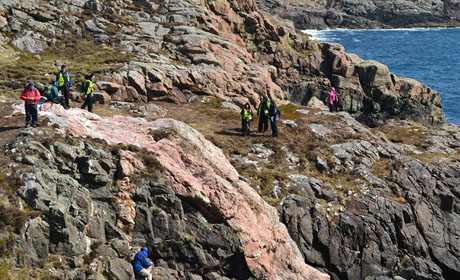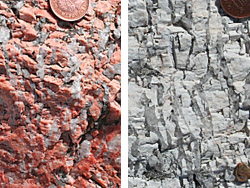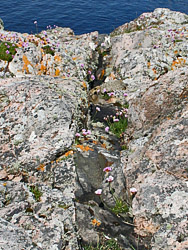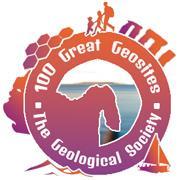Scourie More
Sutherland, Scotland

The area around Scourie on the northwest coast of the Highlands has become a classic site for the study of the geological history of Scotland’s Precambrian basement rocks. Such rocks, known as the Lewisian, are exposed along the west coast from Loch Eriboll towards Loch Maree, but at Scourie, the metamorphic rocks have not been modified since their formation over 2 billion years ago. These rocks, studied in conjunction with the basement rocks elsewhere in the region have allowed the deduction of a geological history that dates back to around 3 billion years.

These Lewisian basement rocks are thought to underlie much of Scotland. However, it is only here on the west coast and on some of the Hebridean islands (particularly the Outer Hebrides) that they are exposed at the surface, though some inliers do exist elsewhere in the Highlands.
Here, the exposures are bounded to the east by the Moine Thrust and to the west by the sea. The rocks in this region are referred to as the Scourian Complex.

Three main regions exist: Northern, Central and Southern, with the Central region lying between Scourie and Gruinard Bay.
The rocks of the Central region have escaped deformation and metamorphism since their formation approximately 2.5 Ga. The rocks of the Northern and Southern regions however have undergone reworking during the Laxfordian.
A (very) simplified chronology of the evolution of the Scourian Complex is as follows:
- 2.9 Billion Years: formation of Scourian sedimentary and igneous rocks
- 2.5 Billion Years: creation of Scourian Complex – granulite to amphibolite facies (high grade metamorphism)
- 2.4 – 2.0 Billion Years: intrusion of Scourie dyke swarm
- 1.7 – 1.1 Billion Years: deformation and metamorphism of Scourian Complex during the Laxfordian
Note: Scourian corresponds to Badcallian event
 The Scourian rocks are mostly banded acid-gneisses that are considered to have a plutonic igneous origin.
The Scourian rocks are mostly banded acid-gneisses that are considered to have a plutonic igneous origin.
Metasediments are uncommon, though still present. The Scourian Complex is therefore considered to have formed in a subduction zone setting. The composition of these rocks corresponds with many other high grade Archaean terranes elsewhere in the world.
 The Scourie dyke swarm covers a large area (at least 120km x 250km), with the dykes generally trending SE-NW or E-W. They are numerous and thought to have been intruded at a time of great crustal extension. The most abundant rock type of the dykes is quartz-dolerite.
The Scourie dyke swarm covers a large area (at least 120km x 250km), with the dykes generally trending SE-NW or E-W. They are numerous and thought to have been intruded at a time of great crustal extension. The most abundant rock type of the dykes is quartz-dolerite.
Text courtesy of ScottishGeology.com
Related Links
Nearby Geosites
- The Foreland Mountains, Assynt
- Achmelvich
- Sub-Torridonian Unconformity on the Assynt Road
- Glencoul
- Laxford Brae Road section
Images:
- Scourie More © Rob Butler
- Garnets © Anne Burgess (Source Geograph.org.uk) Creative Commons Attribution-ShareAlike 2.0 license.
- Folded Gneiss © Anne Burgess (Source Geograph.org.uk) Creative Commons Attribution-ShareAlike 2.0 license.
- 'Graphic' texture formed by intergrowth of Quartz and Feldpar © Anne Burgess (Source Geograph.org.uk: Left and Right) Creative Commons Attribution-ShareAlike 2.0 license.
- Scourie Dyke © Anne Burgess (Source Geograph.org.uk: Left and Right) Creative Commons Attribution-ShareAlike 2.0 license.

October 13 - 21
Theme: 'Earth Science in our lives'
